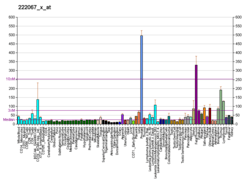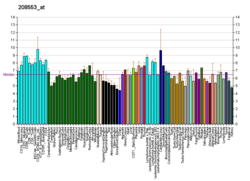HIST1H1E
Histone H1.4 is a protein that in humans is encoded by the HIST1H1E gene.[3][4][5]
Histones are basic nuclear proteins responsible for nucleosome structure of the chromosomal fiber in eukaryotes. Two molecules of each of the four core histones (H2A, H2B, H3, and H4) form an octamer, around which approximately 146 bp of DNA is wrapped in repeating units, called nucleosomes. The linker histone, H1, interacts with linker DNA between nucleosomes and functions in the compaction of chromatin into higher order structures. This gene is intronless and encodes a member of the histone H1 family. Transcripts from this gene lack polyA tails but instead contain a palindromic termination element. This gene is found in the large histone gene cluster on chromosome 6.[5]
References
- 1 2 3 GRCh38: Ensembl release 89: ENSG00000168298 - Ensembl, May 2017
- ↑ "Human PubMed Reference:".
- ↑ Albig W, Kardalinou E, Drabent B, Zimmer A, Doenecke D (Nov 1991). "Isolation and characterization of two human H1 histone genes within clusters of core histone genes". Genomics. 10 (4): 940–8. doi:10.1016/0888-7543(91)90183-F. PMID 1916825.
- ↑ Marzluff WF, Gongidi P, Woods KR, Jin J, Maltais LJ (Oct 2002). "The human and mouse replication-dependent histone genes". Genomics. 80 (5): 487–98. doi:10.1016/S0888-7543(02)96850-3. PMID 12408966.
- 1 2 "Entrez Gene: HIST1H1E histone cluster 1, H1e".
Further reading
- Ohe Y, Hayashi H, Iwai K (1986). "Human spleen histone H1. Isolation and amino acid sequence of a main variant, H1b". J. Biochem. 100 (2): 359–68. PMID 3782055.
- Strom R, Santoro R, D'Erme M, et al. (1995). "Specific variants of H1 histone regulate CpG methylation in eukaryotic DNA". Gene. 157 (1–2): 253–6. doi:10.1016/0378-1119(95)91236-S. PMID 7607502.
- Albig W, Drabent B, Kunz J, et al. (1993). "All known human H1 histone genes except the H1(0) gene are clustered on chromosome 6". Genomics. 16 (3): 649–54. doi:10.1006/geno.1993.1243. PMID 8325638.
- Albig W, Kioschis P, Poustka A, et al. (1997). "Human histone gene organization: nonregular arrangement within a large cluster". Genomics. 40 (2): 314–22. doi:10.1006/geno.1996.4592. PMID 9119399.
- Albig W, Doenecke D (1998). "The human histone gene cluster at the D6S105 locus". Hum. Genet. 101 (3): 284–94. doi:10.1007/s004390050630. PMID 9439656.
- Strausberg RL, Feingold EA, Grouse LH, et al. (2003). "Generation and initial analysis of more than 15,000 full-length human and mouse cDNA sequences". Proc. Natl. Acad. Sci. U.S.A. 99 (26): 16899–903. doi:10.1073/pnas.242603899. PMC 139241. PMID 12477932.
- Morrison H, Jeppesen P (2003). "Allele-specific underacetylation of histone H4 downstream from promoters is associated with X-inactivation in human cells". Chromosome Res. 10 (7): 579–95. doi:10.1023/A:1020966719605. PMID 12498347.
- Mungall AJ, Palmer SA, Sims SK, et al. (2003). "The DNA sequence and analysis of human chromosome 6". Nature. 425 (6960): 805–11. doi:10.1038/nature02055. PMID 14574404.
- Gerhard DS, Wagner L, Feingold EA, et al. (2004). "The status, quality, and expansion of the NIH full-length cDNA project: the Mammalian Gene Collection (MGC)". Genome Res. 14 (10B): 2121–7. doi:10.1101/gr.2596504. PMC 528928. PMID 15489334.
- Garcia BA, Busby SA, Barber CM, et al. (2005). "Characterization of phosphorylation sites on histone H1 isoforms by tandem mass spectrometry". J. Proteome Res. 3 (6): 1219–27. doi:10.1021/pr0498887. PMID 15595731.
- Andersen JS, Lam YW, Leung AK, et al. (2005). "Nucleolar proteome dynamics". Nature. 433 (7021): 77–83. doi:10.1038/nature03207. PMID 15635413.
- Daujat S, Zeissler U, Waldmann T, et al. (2006). "HP1 binds specifically to Lys26-methylated histone H1.4, whereas simultaneous Ser27 phosphorylation blocks HP1 binding". J. Biol. Chem. 280 (45): 38090–5. doi:10.1074/jbc.C500229200. PMID 16127177.
- Olsen JV, Blagoev B, Gnad F, et al. (2006). "Global, in vivo, and site-specific phosphorylation dynamics in signaling networks". Cell. 127 (3): 635–48. doi:10.1016/j.cell.2006.09.026. PMID 17081983.
- Trojer P, Li G, Sims RJ, et al. (2007). "L3MBTL1, a histone-methylation-dependent chromatin lock". Cell. 129 (5): 915–28. doi:10.1016/j.cell.2007.03.048. PMID 17540172.



